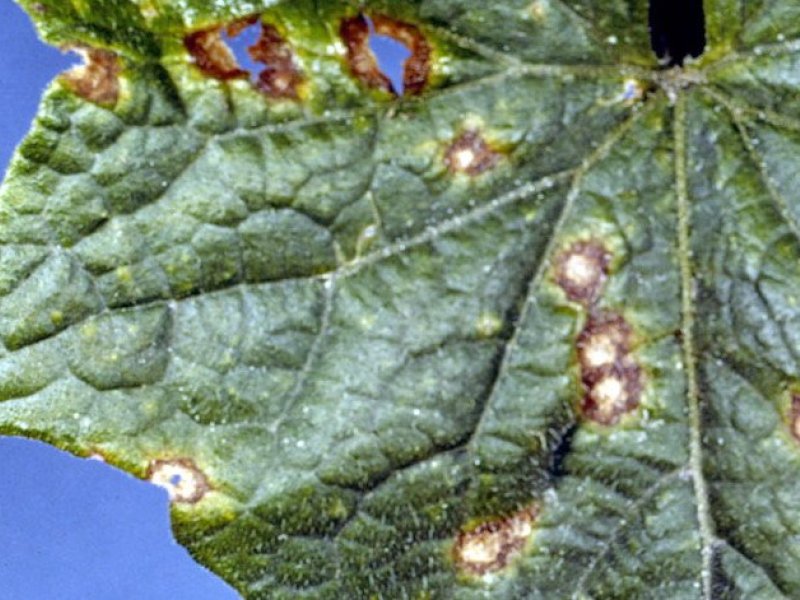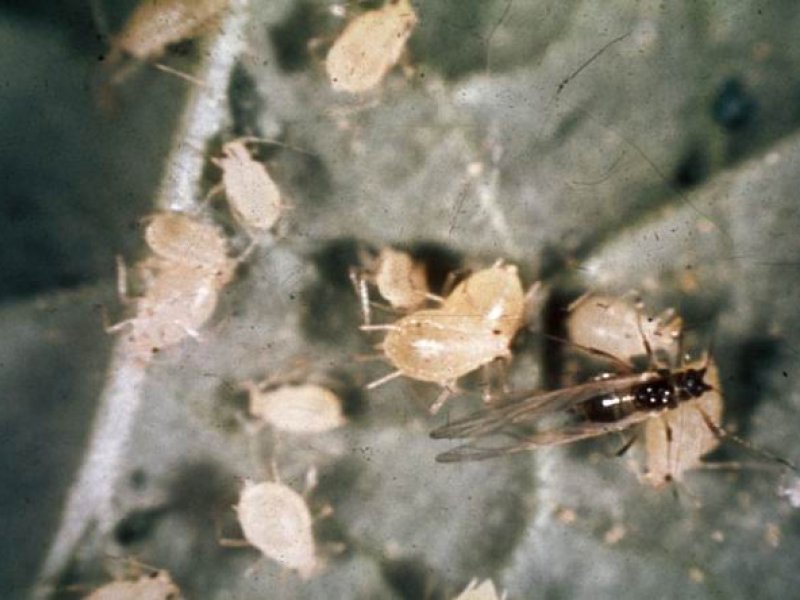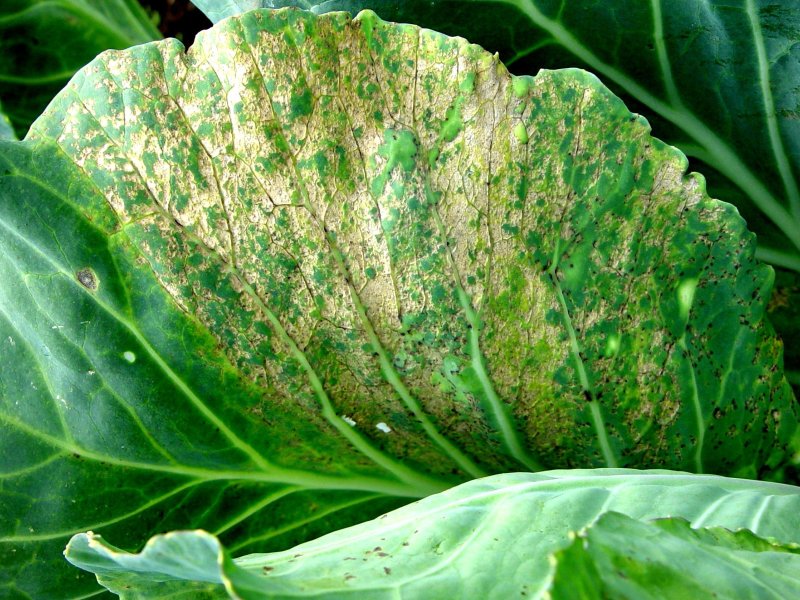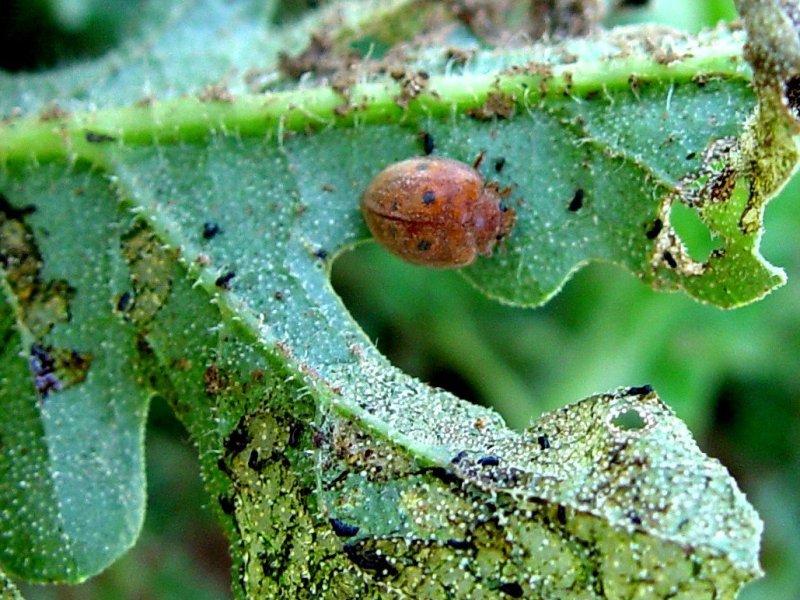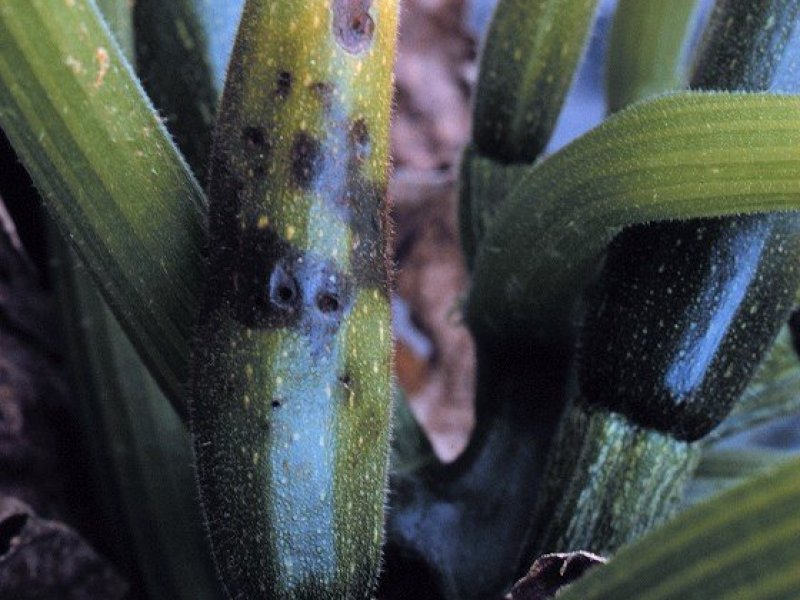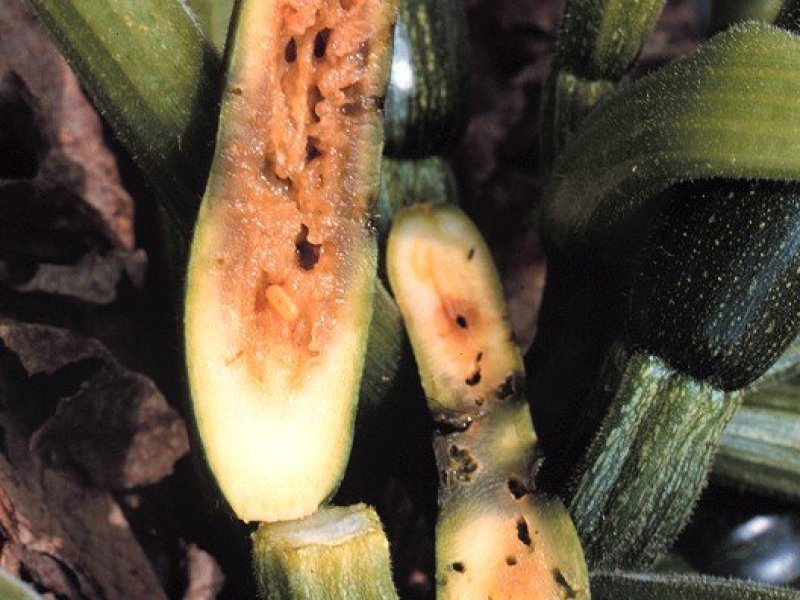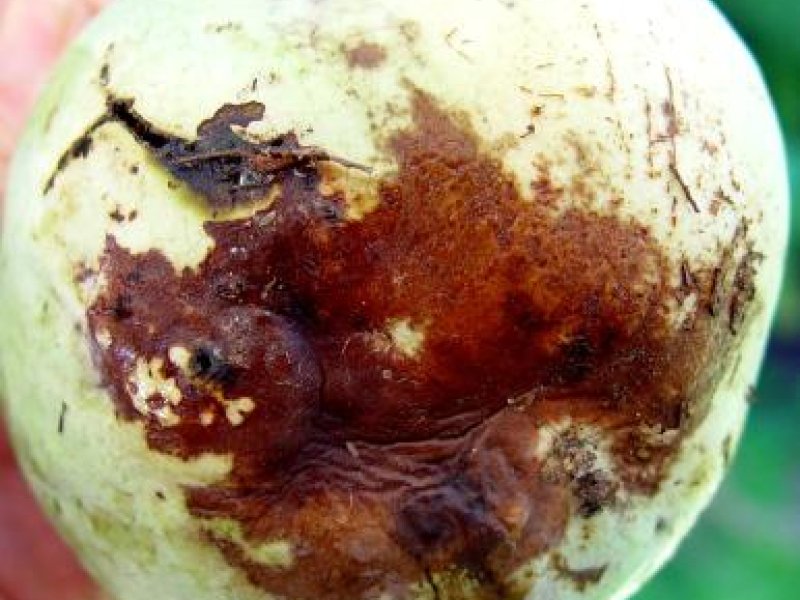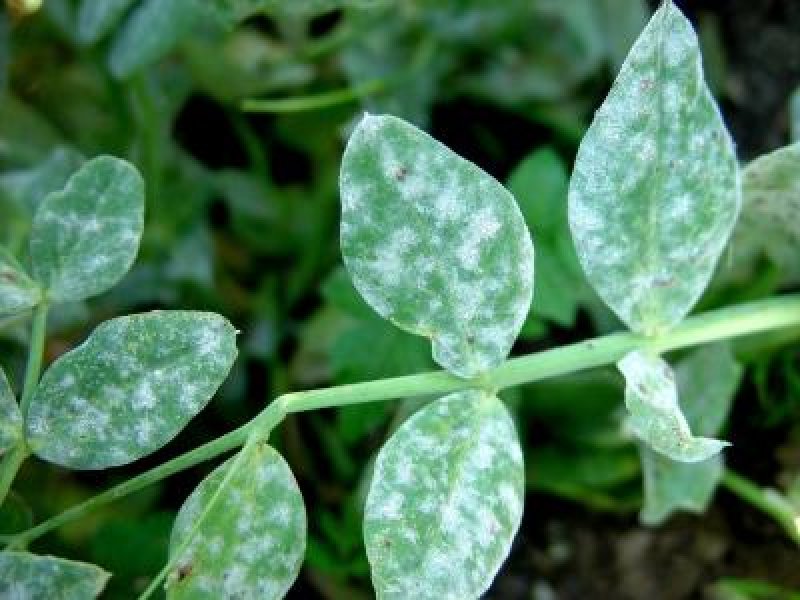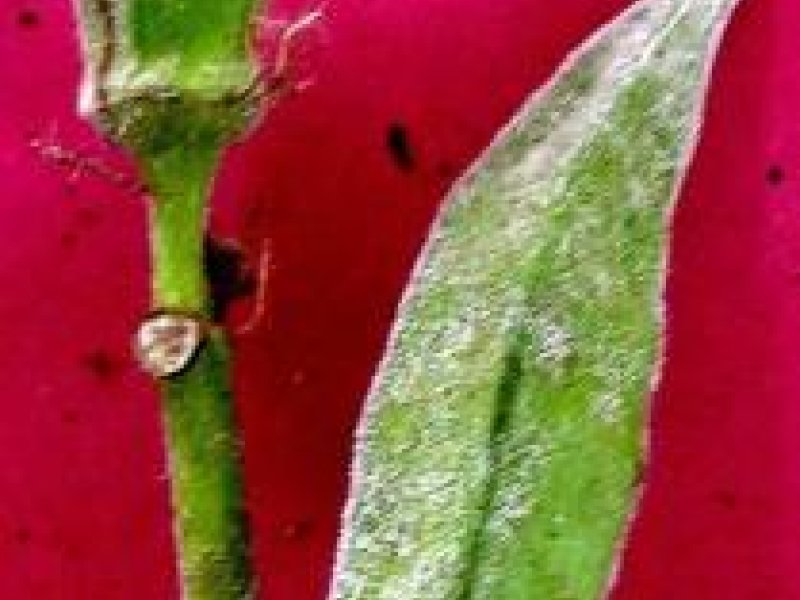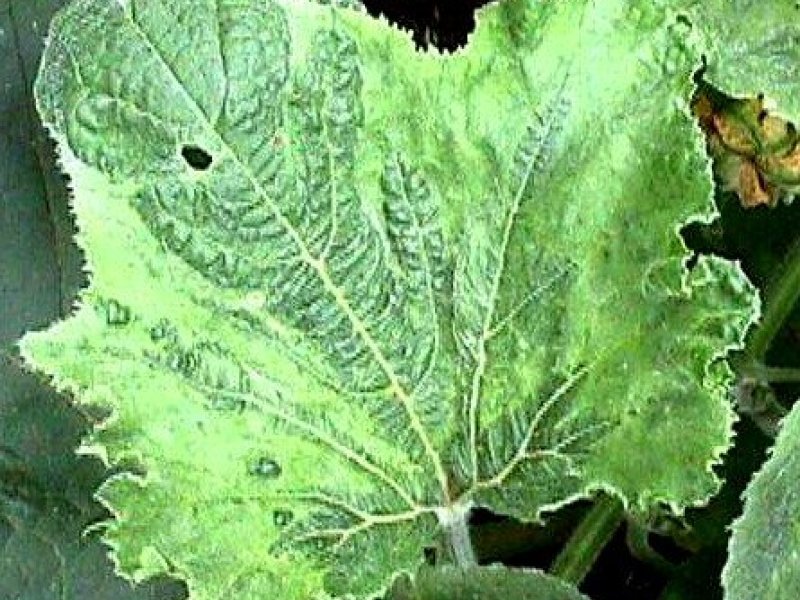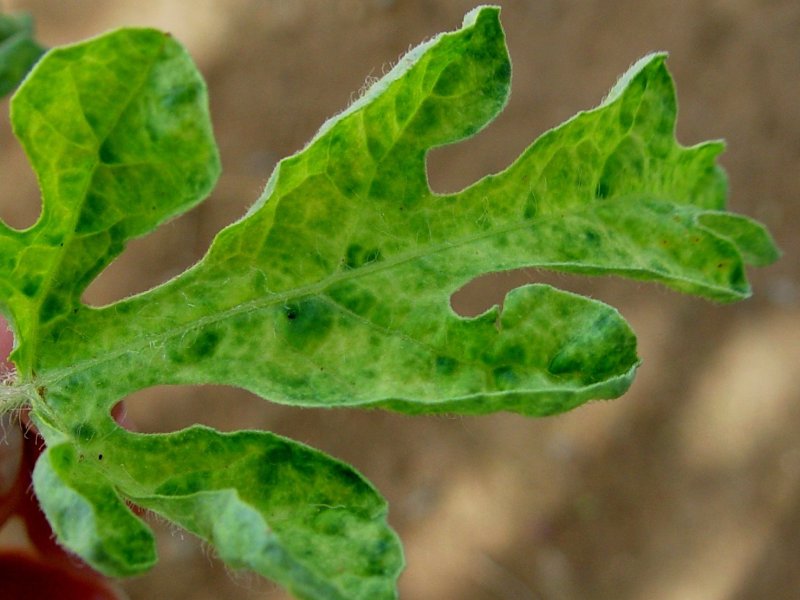|
Anthracnose (Colletotrichum orbiculare) It is the most destructive disease. It causes defoliation and lesions on the fruits. |
|
|
What to do:
|
|
Aphids (Aphis gossypii) The cotton aphid (Aphis gossypii) is common on cucurbits, including cucumber. Colonies of green to blackish aphids are found on tender shoots, mainly on the lower leaf surface, where they suck sap. The growth of the attacked shoots is stunted and the leaves are curled and twisted. Aphids excrete honeydew, which leads to growth of sooty mould, and may attract fruit flies. Aphids, in particular winged aphids, transmit virus diseases (e.g. cucumber mosaic virus) when moving from plant to plant.
|
|
|
What to do:
|
|
Downy mildew (Pseudoperonospora cubensis) Symptoms on leaves appear as small, pale-yellow areas on upper leaf surface. Under humid conditions, a purplish, grey whitish growth may be seen on the underside of the yellowish spots. Affected leaves curl, shrivel and die. |
|
|
What to do:
|
|
Epilachna beetle (Epilachna chrysomelina) Adults of the Epilachna beetle, also known as the African melon ladybird are 6 to 8 mm long, reddish in colour with a number of black spots on the wing cases. The larvae are 7 to 9 mm in length, soft and covered with dark coloured spines. They pupate on leaves. Both adults and larvae feed on the leaves leaving a fine net of veins. Damaged leaves shrivel and dry up. They may also gnaw stems and eat holes in fruits.
These beetles are most likely to be a problem during establishment when plants are small; young plants can be entirely destroyed. Older plants can tolerate considerable leaf damage, but during flowering fruit set maybe affected. This beetle is a vector of squash mosaic virus. The Epilachna beetle attacks all cucurbits. They often fly into a crop from nearby crops.
|
|
|
What to do:
|
|
Fruit flies (Bactrocera cucurbitae, Dacus spp., Ceratitis capitata) Fruit flies are the most serious insect pests on zucchini/squash with the ability to totally wipe out any marketable fruit.
Fruit flies are about 4-7 mm long, they pierce the fruits and lay eggs in fruits. The fruit fly maggots feed inside the fruit causing sunken, discoloured patches, distortions and open cracks. These cracks serve as entry points for fungi and bacteria, causing fruit rot. |
|
|
What to do:
|
|
Powdery mildew (Sphaerotheca fuliginea and Erysiphe cichoracearum) Symptoms first develop as a whitish talcum-like powdery growth on upper leaf surface. The powdery growth is composed of fungal spore mass. These areas covered by white powdery growth may enlarge and join up to cover both lower and upper leaf surfaces. Severely affected leaves dry, turn brown and become brittle. Vines can be also attacked. Secondary effects of the disease include sun-burning and premature ripening of fruits. |
|
|
What to do:
|
|
Virus diseases Many important virus diseases affect cucurbits. These include: Cucumber mosaic cucumovirus (CMV) Watermelon mosaic 2 potyvirus (WMV-2) Watermelon mosaic 1 potyvirus Zucchini yellow mosaic potyvirus (ZYMV) Squash leaf curl bigeminivirus (SLCV) Cucumber mosaic virus It is not seed transmitted except through seed of perennial wild cucumber (Echinocytis lobata) and chickweed (Stellaria media). It is mechanically transmitted and in nature it is spread by various species of aphids. It has a very extensive host range including such varied species as bananas, carrots, cowpeas, lupine, lilies, onions, passion fruit, potatoes and tomatoes. Watermelon mosaic virus This virus is mechanically transmitted and also spread by several species of aphids. It is not seed transmitted. Its host range is primarily restricted to cucurbits although one of its strains infects peas. Squash mosaic virus It is mechanically transmitted. It is transmitted through seeds of melons and squash. It is also transmitted by spotted, striped and banded cucumber beetles, which attack cucumbers in the Americas. The Epilachna beetle (Epilachna chrysomelina) a pest of cucumber in Africa, is also vector of squash mosaic virus. Its host range includes cucurbits, peas, coriander, and salad chervil.
|
|
|
What to do:
|
Geographical Distribution in Africa
Geographical distribution of Zucchini/Courgette in Africa. Updated on 28 November 2018. Source PROTA.
General Information and Agronomic Aspects
Fruits, leaves and flowers of Zucchini and other Cucurbita species are used as vegetables, and their seeds are consumed roasted as a snack food (CAB 2006). Zucchini has a mild flavour and is very watery. It is often harvested when still very young. At this stage it is also called squash or courgette. Because the fruit has very little flavour of its own it is often used as a base for making savoury dishes.
The seeds can be scooped out of and a replaced with a filling - this can then be baked (Plants for a Future 2003). Ornamental gourds are cultivars of C. pepo with small, bitter and inedible fruits in many shapes, sizes and colours (CAB 2006).
Nutritive Value per 100 g of edible Portion
| Raw or Cooked Zucchini |
Food\ Energy (Calories / %Daily Value*) |
Carbohydrates (g / %DV) | Fat (g / %DV) | Protein (g / %DV) | Calcium (g / %DV) | Phosphorus (mg / %DV) | Iron (mg / %DV) | Potassium (mg / %DV) | Vitamin A (I.U) | Vitamin C (I.U) | Vitamin B 6 (I.U) | Vitamin B 12 (I.U) | Thiamine (mg / %DV) | Riboflavin (mg / %DV) | Ash (g / %DV) |
| Zucchini with skin cooked | 16.0 / 1% | 3.9 / 1% | 0.1 / 0% | 0.6 / 1% | 13.0 / 1% | 40.0 / 4% | 0.4 / 2% | 253 / 7% | 1117 IU / 22% | 4.6 / 8% | 0.1 / 4% | 0.0 / 0% | 0.0 / 3% | 0.0 / 2% | 0.6 |
| Zucchini with skin raw | 16.0 / 1% | 3.3 / 1% | 0.2 / 0% | 1.2 / 2% | 15.0 / 1% | 38.0 / 4% | 0.4 / 2% | 262 / 7% | 200 IU / 4% | 17.0 / 28% | 0.2 / 11% | 0.0 / 0% | 0.0 / 3% | 0.1 / 8% | 0.6 |
*Percent Daily Values (DV) are based on a 2000 calorie diet. Your daily values may be higher or lower, depending on your calorie needs.
Climatic conditions, soil and water management
Zucchini requires a rich, well-drained soil that is able to retain moisture. It grows best in a sunny and sheltered position. Plants are tolerant to light shade. It prefers a pH of 5.5 to 5.9, but tolerates up to 6.8 (Plants for a Future 2003). It responds very well to fairly heavy applications of good compost or well-decomposed manure in the planting hills or ridges. Drought stress quickly reduces fruit setting, so during dry spells irrigation is a must, preferably watering below the leaves or using drip irrigation.
Propagation and planting
Zucchini and squashes are grown from seed. Seeds may be sown in containers and transplanted to the field when they are 10 cm high or have 2 real leaves. Direct seeding of two to three per hill is also commonly practised. Trailing types are planted at distances of 2 to 3 m either way; the seed requirement is 2 to 3 kg/ha. The bushy types are planted closer, for example, plants spaced 60 to 120 cm in rows 1 to 1.5 m apart. The seed requirement for Zucchini is 7 kg/ha. Plant densities vary from 5,000 plants per ha for the long-running trailing forms to 20,000 plants per ha for the bushy types (CAB 2006).
Varieties grown in Kenya include Ambassador F1, Black beauty, Green Zuchinni Cera F1, Simba F1, Star 8021, Squash Black Beauty and Dark Green Zucchini.
Husbandry
Sole cropping is normally used for commercial production. Zucchini and squashes are also planted in home gardens as fresh vegetables. Cultural practices to improve growth and development include the removal of growing tips to check growth in case of trailing varieties.
Harvesting
Zucchini and other summer squashes, from which the immature fruit is used as a fresh vegetable, develop very rapidly. The first marketable fruits can be harvested 50 to 60 days after planting, or 3 to 6 days after appearance of the female flower. During the harvest season the fruits are harvested two to three times per week. (CAB 2006)
Crop yields for summer squash (immature fruits) are 7 to 12 t/ha. Unless grown for seed, mature fruits are not marketable, so plants are removed when yields become too low. Indicative figures for seed yield of zucchini and other squashes are 400 to 1500 kg/ha. In seed production, isolation between fields of different Cucurbita species is recommended, not only for reason of purity but also for obtaining maximum yields (pollen of other species may cause reduced fruit set).
Summer squash of good quality can be kept for up to 14 days when stored at 7 to 10°C and 85 to 95% RH (CAB 2006).
Information on Pests
General Information
Courgettes are affected by similar pests as other cucurbits as they belong to the same family of Cucurbitacea. Other members of this family include melons, squash, pumpkin, and cucumber.The leaf-feeding Epilachna beetles are a serious problem for Cucurbita growers. Aphids and various leaf beetles can also cause problems on courgetes.For more information on courgette pests refer to datasheet on Cucumber click here.
| Fruit flies (Bactrocera cucurbitae, Dacus spp., Ceratitis capitata) Fruit flies are the most serious insect pests on zucchini/squash with the ability to totally wipe out any marketable fruit.
Fruit flies are about 4-7 mm long, they pierce the fruits and lay eggs in fruits. The fruit fly maggots feed inside the fruit causing sunken, discoloured patches, distortions and open cracks. These cracks serve as entry points for fungi and bacteria, causing fruit rot. What to do:
|
| The cotton aphid (Aphis gossypii) is common on cucurbits, including cucumber. Colonies of green to blackish aphids are found on tender shoots, mainly on the lower leaf surface, where they suck sap. The growth of the attacked shoots is stunted and the leaves are curled and twisted. Aphids excrete honeydew, which leads to growth of sooty mould, and may attract fruit flies. Aphids, in particular winged aphids, transmit virus diseases (e.g. cucumber mosaic virus) when moving from plant to plant.
What to do:
|
| Epilachna beetle (Epilachna chrysomelina) Adults of the Epilachna beetle, also known as the African melon ladybird are 6 to 8 mm long, reddish in colour with a number of black spots on the wing cases. The larvae are 7 to 9 mm in length, soft and covered with dark coloured spines. They pupate on leaves. Both adults and larvae feed on the leaves leaving a fine net of veins. Damaged leaves shrivel and dry up. They may also gnaw stems and eat holes in fruits.
These beetles are most likely to be a problem during establishment when plants are small; young plants can be entirely destroyed. Older plants can tolerate considerable leaf damage, but during flowering fruit set maybe affected. This beetle is a vector of squash mosaic virus. The Epilachna beetle attacks all cucurbits. They often fly into a crop from nearby crops.
What to do:
|
Information on Diseases
General Information
Courgettes are affected by similar diseases as other cucurbits as they belong to the same family of Cucurbitacea. Other members of this family include melons, squash, pumpkin, and cucumber. Anthracnose (Colletotrichum orbiculare) is the most destructive disease. It causes defoliation and lesions on the fruits.Other fungal diseases, mainly affecting the leaves and stems are:
- Powdery mildew (Erysiphe cichoracearum)
- Downy mildew (Peronospora cubensis)
- Scab (Cladosporium cucumerinum)
Many important virus diseases affect cucurbits. These include Cucumber mosaic cucumovirus (CMV), Watermelon mosaic 2 potyvirus (WMV-2), Watermelon mosaic 1 potyvirus, Zucchini yellow mosaic potyvirus (ZYMV), Squash leaf curl bigeminivirus (SLCV).For more information on these diseases refer to datasheet on Cucumber click here.
| Powdery mildew (Sphaerotheca fuliginea and Erysiphe cichoracearum) Symptoms first develop as a whitish talcum-like powdery growth on upper leaf surface. The powdery growth is composed of fungal spore mass. These areas covered by white powdery growth may enlarge and join up to cover both lower and upper leaf surfaces. Severely affected leaves dry, turn brown and become brittle. Vines can be also attacked. Secondary effects of the disease include sun-burning and premature ripening of fruits. What to do:
|
| Downy mildew (Pseudoperonospora cubensis) Symptoms on leaves appear as small, pale-yellow areas on upper leaf surface. Under humid conditions, a purplish, grey whitish growth may be seen on the underside of the yellowish spots. Affected leaves curl, shrivel and die. What to do:
|
| Anthracnose (Colletotrichum orbiculare) It is the most destructive disease. It causes defoliation and lesions on the fruits. What to do:
|
| Many important virus diseases affect cucurbits. These include: Cucumber mosaic cucumovirus (CMV) Watermelon mosaic 2 potyvirus (WMV-2) Watermelon mosaic 1 potyvirus Zucchini yellow mosaic potyvirus (ZYMV) Squash leaf curl bigeminivirus (SLCV) Cucumber mosaic virus It is not seed transmitted except through seed of perennial wild cucumber (Echinocytis lobata) and chickweed (Stellaria media). It is mechanically transmitted and in nature it is spread by various species of aphids. It has a very extensive host range including such varied species as bananas, carrots, cowpeas, lupine, lilies, onions, passion fruit, potatoes and tomatoes. Watermelon mosaic virus This virus is mechanically transmitted and also spread by several species of aphids. It is not seed transmitted. Its host range is primarily restricted to cucurbits although one of its strains infects peas. Squash mosaic virus It is mechanically transmitted. It is transmitted through seeds of melons and squash. It is also transmitted by spotted, striped and banded cucumber beetles, which attack cucumbers in the Americas. The Epilachna beetle (Epilachna chrysomelina) a pest of cucumber in Africa, is also vector of squash mosaic virus. Its host range includes cucurbits, peas, coriander, and salad chervil.
What to do:
|
Information Source Links
- AIC, Nairobi (2003). Fruits and Vegetables Technical Handbook
- AVRDC International Cooperators' Factsheet on Cucurbits www.avrdc.org
- Beije, C.M., Kanyangia,S.T., Muriuki, S.J.N., Otieno, E.A., Seif, A.A., Whittle, A.M. (1984). Horticultural Crops Protection Handbook. National Horticultural Research Station, Thika. KEN/75/028 and KEN/80/017/
- Blay, E., Cudjoe, A. R., Braun M. (Eds) (2000). Handbook of crop protection recommendations in Ghana: An IPM approach. Vol 2; vegetables. Plant Protection & Regulatory Services Directorate (PPRSD) and the Integrated Crop Protection Project, German Development Cooperation (GTZ).
- Bohlen, E. (1973). Crop pest in Tanzania and their control. Federal Agency for Economic Cooperation (BFE). Veralgh Paul Parey. ISBN 3-489-64826-9.
- CAB (2005). Crop Protection Compendium, 2005 Edition. © CAB International Publishing. www.cabi.org
- CAB (2006). Crop Protection Compendium, 2006 Edition. © CAB International Publishing. www.cabi.org
- EcoPort. The consilience engine. www.ecoport.org
- Ekesi, S., Billah M. K. (Eds) (2006. A field guide to the management of economically important tephritid fruit flies in Africa. ICIPE. ISBN: 92-9064-179-7.
- Ministry of Agriculture and Rural Development (Kenya) (MoARD) & Japan International Cooperation Agency (JICA) (2000). Local and Export Vegetables Growing Manual. Reprinted by Agricultural Information Resource Centre, Nairobi, Kenya. 274 pp.
- Nutrition Data www.nutritiondata.com.
- Ostermann, H. and Dreyer, M. (1995). Vegetables and grain legumes. In: The Neem tree Azadirachta indica A. Juss. and other meliaceous plants sources of unique natural products for integrated pest management, industry and other purposes? Edited by H. Schmutterer in collaboration with K. R. S. Ascher, M. B. Isman, M. Jacobson, C. M. Ketkar, W. Kraus, H. Rembolt, and R.C. Saxena. VCH. pp. 392-403. ISBN: 3-527-30054-6
- Park SoDeuk, Kwon TaeYong, Lim Yang Sook, Jung KiChae, Choi BooSull (1996). Disease survey in melon, watermelon, and cucumber with different successive cropping periods under vinyl house conditions. Korean Journal of Plant Pathology, 12(4):428-431.
- Plants for a Future (2003). Edible, medicinal and useful plants for a healthier world. www.pfaf.org
- PROTA
- Sherf, A.F., Macnab, A.A. (1986). Vegetable Diseases and Their Control. 2nd. Edition. John Wiley & Sons Inc. USA. ISBN: 0-471-05860-2
- University of Georgia: College of Agricultural and Environmental Sciences, Department of Horticulture Vegetable Crops: Pumpkin.
Contact Links
- For information on small scale farming techniques, seeds, equipment and insecticides (e.g. pyrethrum solution).HYGROTECH EAST AFRICA, LTD Region :KENYA / TANZANIA - Address :P.O.Box 41446, Nairobi, Tigoni Centre, Limuru Road, KENYA Phone :+254 (0) 20 205 3916,0722 205 148 E-Mail: info@hygrotech.co.ke

